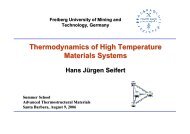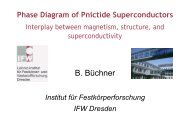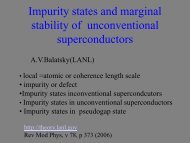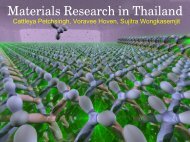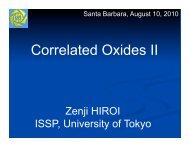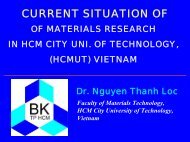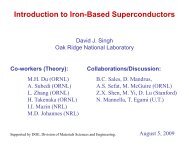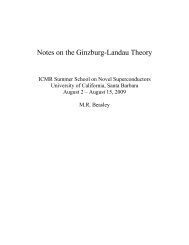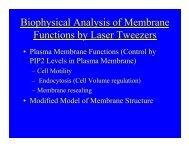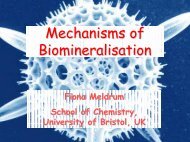Planar tunneling and andreev Reflection - International Center for ...
Planar tunneling and andreev Reflection - International Center for ...
Planar tunneling and andreev Reflection - International Center for ...
Create successful ePaper yourself
Turn your PDF publications into a flip-book with our unique Google optimized e-Paper software.
<strong>Planar</strong> Tunneling <strong>and</strong> Andreev <br />
Reflec2on: Powerful probes of the <br />
superconduc2ng order parameter <br />
Laura H. Greene <br />
Department of Physics<br />
<strong>Center</strong> <strong>for</strong> Emergent Superconduc8vity<br />
Frederick Seitz Materials Research Laboratory<br />
<strong>Center</strong> <strong>for</strong> Nanoscale Science <strong>and</strong> Technology<br />
University of Illinois at Urbana‐Champaign<br />
Urbana, IL 61801 USA<br />
lhgreene@illinois.edu <br />
ICMR Summer School on Novel Superconductors <br />
August 2 – 15, 2009 UCSB
Outline: <br />
Lecture 1 (Tunneling spectroscopy on HTS): <br />
• Promo: Gr<strong>and</strong> statement / DoE‐BES report / new SCs <br />
• Broken symmetries (gauge, reflec@on <strong>and</strong> @me‐reversal) <br />
• Tunneling <strong>and</strong> order parameter (OP) symmetry <br />
• Andreev reflec2on (AR) <br />
• Tunneling into Andreev bound states: Broken symmetries <br />
Lecture 2 (Andreev reflec2on spectroscopy on HFs): <br />
• Point Contact Andreev Reflec@on Tunneling Spectroscopy (PCARTS) <br />
• Blonder‐Tinkham‐Klapwijk (BTK) theory <strong>and</strong> it’s extension to d‐wave <br />
• Defini@on of the issues (AR at HFSs <strong>and</strong> spectroscopy of HFs) <br />
• CeCoIn5 <strong>and</strong> related HFs <br />
Describe data with a two‐fluid model <strong>and</strong> Fano resonance in an <br />
energy‐dependent DoS
Our 2006 REPORT (with “Tc vs. Time”) <br />
http://www.sc.doe.gov/bes/reports.lists.html
2008 Surprise <br />
Iron‐based HTS !!!
Today’s “Tc vs. Time” with NEW HTS <br />
The First HTS are NOT UNIQUE!!!
Broken Symmetries ‐ 1 (overview) <br />
Gauge / Phase <br />
Reflec@on <br />
Time Reversal <br />
Superconduc@vity d‐wave Ferromagne@sm
Broken Symmetries – 2 (defini@ons) <br />
Symmetry State Broken Symmetry State<br />
1. <br />
Homogeneous<br />
w.r.t. coordinate<br />
(distance, angle,<br />
Inhomogeneous<br />
w.r.t. coordinate<br />
phase, 8me, .. )<br />
2. <br />
“The symmetry of the<br />
state is the same as<br />
that of the Hamiltonian”<br />
“The symmetry of the<br />
state is lower than<br />
that of the Hamiltonian”.<br />
3. <br />
Changing the coordinate<br />
does not produce a<br />
measurable change<br />
Changing a coordinate<br />
does produce a<br />
measurable change
Broken Symmetries – 3: Symmetry vs. Broken Symmetry <br />
Symmetry: <br />
Symmetry State <br />
Broken Symmetry <br />
Circular <br />
<br />
spontaneous <br />
Phase / Gauge<br />
driven <br />
Metal <br />
Light Laser <br />
bulb <br />
Superconductor
Broken Time‐Reversal Symmetry
Gauge / Phase Symmetry Symmetric
Broken Symmetries – 4 (some ramifica@ons of <br />
broken gauge symmetry) <br />
Photons (driven) <br />
Single‐Slit<br />
Diffrac>on: <br />
Electrons (spontaneous)<br />
rf Squid: <br />
H<br />
Intensity <br />
V H<br />
×<br />
Jc <br />
Double‐Slit<br />
Diffrac>on: <br />
Intensity <br />
dc Squid: <br />
V H<br />
×<br />
Jc <br />
H
Electron Tunneling Spectroscopy (I) <br />
(<strong>Planar</strong> quasipar@cle overview) <br />
1<br />
2 <br />
Electrode 1<br />
e ik L•x<br />
Electrode 2<br />
e ik R•x
Electron Tunneling Spectroscopy (II) <br />
Quantum Mechanical <br />
Tunneling <br />
<strong>Planar</strong> Tunnel Junc@on <br />
I<br />
dI<br />
V<br />
d<br />
V<br />
Normal metal <br />
Insulator <br />
Tunnel barrier <br />
Superconductor <br />
Substrate <br />
Al/AlO x /Pb, Giaever (PRL 5 147,1960)
Electron Tunneling Spectroscopy (III)
Electron Tunneling Spectroscopy (IV) <br />
(<strong>Planar</strong> vs. STM) <br />
Measurements compliment each other: <br />
<strong>Planar</strong> Tunneling <br />
STM <br />
Advantages: <br />
I. Small <strong>tunneling</strong> cone: <br />
Intrinsic momentum resolu@on <strong>for</strong> smooth surfaces <br />
II. Stable configura@on: <br />
can easily study as a func@on of field, temperature, <br />
area <strong>and</strong>, most important, reproducibility. <br />
Drawbacks: <br />
I. Damage to surface during junc@on fabrica@on <br />
II. Low spa@al resolu@on
Electron Tunneling Spectroscopy (V) <br />
Normalized Conductance<br />
‐4 ‐2 0 2 4<br />
eV / Δ<br />
Current<br />
• Bias dependence of <strong>tunneling</strong> <br />
conductance directly probes DOS. <br />
• Tunneling is a well‐established <br />
technique to study SC energy gap.
Electron Tunneling Spectroscopy (VI) <br />
Measured Tunneling Conductance of a <br />
High‐Temperature Superconductor <br />
gap, 2Δ <br />
The central peak <br />
arises from Andreev <br />
Bound States, from <br />
broken reflec2on <br />
symmetry of the <br />
superconduc@ng <br />
order parameter <br />
(meV) <br />
Review: d‐wave SC <strong>and</strong> Andreev reflec8on …
Electron Tunneling Spectroscopy (VII) <br />
Superconducting Order Parameter <br />
s‐wave <br />
d‐wave
Electron Tunneling Spectroscopy (VIII) <br />
(Gap / OP symmetry) <br />
Broken <br />
Reflec@on <br />
Symmetry <br />
“Conven@onal” <br />
“Unconven@onal”
D‐wave was already shown: <br />
Josephson Junction (Wollman et al.)<br />
1997 Buckley Prize: Van Harlingen, Ginsberg (this exp’t); Kirtley, Tsui<br />
Cri@cal current<br />
1.0<br />
0.8<br />
0.6<br />
0.4<br />
0.2<br />
s-wave<br />
+<br />
d-wave<br />
+<br />
‐<br />
‐<br />
+<br />
0.0<br />
‐6 ‐4 ‐2 0 2 4 6<br />
Magne@c flux<br />
6 4 2 0 ‐2 ‐4 ‐6<br />
Magne@c flux<br />
Cri@cal current ( µ A)<br />
60<br />
40<br />
20<br />
DAT<br />
A:<br />
0<br />
‐1000 ‐500 0 500 1000<br />
Applied magne@c field (mG)
Andreev <strong>Reflection</strong> (I)<br />
What will happen to an electron with E < Δ <strong>and</strong> no tunnel barrier?<br />
insulator <br />
e e <br />
normal <br />
metal <br />
specular reflec@on <br />
cf. At an interface with huge <br />
poten@al barrier that is <br />
transla@onally invariant along the <br />
transverse direc@on, incoming <br />
electrons reflect specularly. <br />
• Within the gap, no quasipar@cle <br />
states available, no single par@cles <br />
can enter S. <br />
• Will a normal‐metal/<br />
superconductor (N/S) system be less <br />
conduc@ve that a single N? <br />
• No!
Andreev <strong>Reflection</strong> (II)<br />
N. V. Zavaritskii,<br />
Sov. Phys. JETP<br />
11, 1207 (1960)<br />
• While trying to explain the rapid <br />
increase of thermal resistance of Sn in <br />
the intermediate state, Andreev <br />
discovered that an addi@onal scaoering <br />
must be involved. A. F. Andreev, Sov. Phys. JETP 19,<br />
1228 (1964)<br />
• QM scaoering off SC pair poten@al near <br />
N/S <br />
• Par@cle‐hole conversion process <br />
mul@‐par@cle (AR) vs. single par@cle <br />
(<strong>tunneling</strong>) <br />
• Retro‐reflec@on v h = -v e
Andreev <strong>Reflection</strong> (III)<br />
• Conserved quan@@es <br />
‐ Energy (E) <br />
‐ Momentum (hk) (Δ
(defini@on) <br />
Normal Metal/Superconductor (N/S) interface <br />
In N: <br />
Electrons <br />
retroreflected as <br />
holes <br />
Andreev <strong>Reflection</strong> (IV)<br />
h + <br />
N<br />
e ‐ <br />
S <br />
Probability of finding Cooper Pairs <br />
In S: <br />
Cooper <br />
Pairs <br />
Broken <br />
near <br />
interface <br />
Induced phase coherence <br />
Pair Breaking <br />
N S
Andreev <strong>Reflection</strong> (V)<br />
(energy scales) <br />
E F (few eV) <br />
E <br />
Δ (few meV) <br />
≈<br />
≈<br />
N <br />
S <br />
k <br />
Par@cle conversion process that conserves <br />
charge, energy <strong>and</strong> momentum!
Andreev <strong>Reflection</strong> (VI)<br />
(within a superconductor) <br />
+<br />
P out <br />
Andreev <br />
Bound <br />
States ABS <br />
+<br />
‐ <br />
P out <br />
P in <br />
P in <br />
s‐wave: <br />
No Andreev Reflec@on <br />
(order parameter isotropic) <br />
⇒ Cooper Pairs <br />
not Broken <br />
d‐wave: <br />
Strong Andreev Reflec@on <br />
(order parameter sign change) <br />
⇒ Cooper Pairs <br />
Broken <br />
Quasipar@cles nucleate at surface <strong>for</strong>ming <br />
Andreev Bound States <br />
(Bound w/in ~coherence length of surface)
Andreev <strong>Reflection</strong> (VII)<br />
(Andreev bound states, ABS) <br />
(110) <br />
surface <br />
+ <br />
‐ <br />
~ξ 0<br />
<br />
DoE <br />
(E=0) <br />
D <br />
P' F <br />
P F <br />
x <br />
Cooper Pair Quasi‐Classical Trajectory along D: <br />
+Δ <br />
P F <br />
P' F <br />
‐Δ <br />
Sign‐change of OP is only Boundary <br />
Condi@on in the Solu@on to Andreev <br />
Equa@ons: Quasipar@cle Bound States <br />
at surface (decay ~ξ 0 ) <br />
DoE <br />
D <br />
Peak at zero bias (Fermi energy) arises <br />
from quasipar@cles at Fermi energy in <br />
near‐surface region <br />
eV
Electron Tunneling Spectroscopy (IX) <br />
(Diagnos@cs of ZBCP ‐ a) <br />
Several phenomena will produce a ZBCP <br />
(zero‐bias conductance peak) in <strong>tunneling</strong> <br />
1. Magne@c scaoering (spin‐flip, Kondo) <br />
2. Proximity effects <br />
3. Josephson current <br />
4. Shorts / pinholes through tunnel barrier <br />
5. Cooper‐pair <strong>tunneling</strong> <br />
6. Reflec@onless <strong>tunneling</strong> <br />
7. Inelas@c processes <br />
8. ABS (Andreev bound states) <br />
…..etc., etc.,….. <br />
DIAGNOSTICS are REQUIRED to determine <br />
if the zero bias conductance peak arises from ABS <br />
(intrinsic to any unconven@onal superconductor)
Electron Tunneling Spectroscopy (X) <br />
(Diagnos@cs of ZBCP ‐ b) <br />
1. Crystallographic orienta2on <br />
• Only seen in ab‐plane <strong>tunneling</strong> (not in c‐axis) <br />
• Not seen in specular (100) a‐axis <strong>tunneling</strong> <br />
• Magnitude depends upon ab‐plane crystallographic orienta@on <br />
2. Temperature <br />
• Split in ZBCP below T s<br />
<br />
• Zero‐bias conductance ~1/T below 40K, above T s<br />
<br />
3. Magne2c Field <br />
• Field Evolu@on <br />
• Satura@on effects <br />
• Field Scale <br />
• Angular or orienta@onal dependence of the applied field <br />
• Hysteresis <br />
4. Doping <strong>and</strong> disorder <br />
• ZBCP reduces in size <strong>and</strong> disappears with increased doping <br />
<strong>and</strong> ion‐induced damage. <br />
• This is shown to be a DoS effect (follows gap disorder dependence) <br />
∴ Observed Zero Bias Conductance Peaks arise from ABS
Electron Tunneling Spectroscopy (XI) <br />
(Film growth <strong>and</strong> diagnos@cs) <br />
Off‐Axis <strong>Planar</strong> Magnetron Spuoer Deposi@on: <br />
Film: <br />
(target stoichiometry) <br />
Substrate <br />
(oriented SrTiO3…) <br />
Ar:O<br />
plasma <br />
Spuoer gun <br />
Stoichiometric Target: <br />
YBa 2<br />
Cu 3<br />
O 7<br />
<br />
(or doped species) <br />
Heater <br />
Reproducible films of (001), (100) <strong>and</strong> (103) <strong>and</strong> (110)‐oriented YBa 2<br />
Cu 3<br />
O 7<br />
, <br />
(Y x<br />
Pr 1‐x<br />
)Ba 2<br />
Cu 3<br />
O 7<br />
, YBa 2<br />
(Cu x<br />
Ni 1‐x<br />
) 3<br />
O 7<br />
, YBa 2<br />
(Cu x<br />
Zn 1‐x<br />
) 3<br />
O 7 <br />
<br />
Materials Analysis includes: <br />
Electronic transport (resis@vity vs. temperature, <strong>tunneling</strong>) <br />
Magne@za@on (suscep@bility vs. temperature) <br />
Structural analysis (XRD, RBS, SEM, AFM, etc.,…)∙
Electron Tunneling Spectroscopy (XII) <br />
Possible Orienta2ons of CuO 2 Planes <br />
(001) “c‐axis” <br />
(100) “a‐axis” <br />
“Non‐C‐axis” <br />
(103) or (013) <br />
(110) “a‐b axis” <br />
YBCO thin films, or cut crystal faces
Electron Tunneling Spectroscopy (XIII) <br />
(junc@on growth <strong>and</strong> diagnos@cs) <br />
Pb <br />
YBa 2<br />
Cu 3<br />
O 7<br />
<br />
Insulator <br />
Tunnel barrier <br />
I <br />
∙ Pb counter‐electrodes evaporated ex‐situ. <br />
TUNNELING VERIFIED by:<br />
1. Quality of the observed Density of States (DoS) of the <br />
superconduc@ng Pb counter electrode, OR the now <br />
well‐known YBCO DoS <br />
2. Junc@on resistance: scales with 1/A junc@on<br />
<br />
3. Liole to no temperature dependence <br />
4. REPRODUCIBLITY <br />
V
Electron Tunneling Spectroscopy (XIV) <br />
(Junc@on diagnos@cs: DoS) <br />
Many ways to grow REPODUCIBLE junc@ons <strong>for</strong> planar <strong>tunneling</strong> <br />
spectroscopy <br />
+V filling YBCO states <br />
(meV) <br />
(110) YBCO/Ag T=1.2K
Electron Tunneling Spectroscopy (XV) <br />
(Junc@on diagnos@cs: Crystallographic Orienta@on <br />
1.6 <br />
1.4 <br />
G/G(60 mV) <br />
1.2 <br />
1.0 <br />
0.8 <br />
c‐axis <br />
ab‐plane <br />
0.6 <br />
T = 1.5 K <br />
H = 2 kG <br />
0.4 <br />
‐80 ‐60 ‐40 ‐20 0 20 40 60 80 <br />
Voltage (mV) <br />
YBCO / Pb <br />
M. Covington & LHG, PRB 62, 12440 (2000)
Electron Tunneling Spectroscopy (XVI) <br />
(Magne@c field dependence ‐ a) <br />
J. Lesueur et al, Physics C (1992); M. Covington et al, PRB (2000)
Electron Tunneling Spectroscopy (XVII) <br />
(Magne@c field dependence ‐ b) <br />
Fit: Doppler shift<br />
<strong>and</strong> pair-breaking<br />
at Hc (Fogelström,<br />
Rainer, Sauls, ‘97)*<br />
Old Kondo resonance <br />
<strong>tunneling</strong> data: <br />
= 2gμ B H (linear) <br />
*Lesueur, (92-00); Covington (97-00); Aprili (99); Deutscher (99-05).....
Electron Tunneling Spectroscopy (XVIII)
Electron Tunneling Spectroscopy (XIX) <br />
(Magne@c Field Dependence – c: Xtal Orienta@on <br />
V (mV) <br />
Highly ‐ anisotropic QP transport: ABS carry current <br />
parallel ab‐planes (not in c‐axis direc>on)! <br />
M. Aprili et al, PRL (1999); Krupke et al PRL (1999) <br />
Splisng ∝ V F • P s
Electron Tunneling Spectroscopy (XX) <br />
(Origin of field spli~ng) <br />
Andreev bound states carry current along the interface <br />
Applied Magne2c field, Happl , induces a Doppler Shit: <br />
δ = δ s<br />
+ (e/c) v F<br />
λ sinφ c<br />
H appl<br />
<br />
spliTng ∝ H applied<br />
δ = ABS spli]ng <br />
λ = penetra8on depth <br />
v F<br />
= of <strong>tunneling</strong><br />
electrons <br />
φ c<br />
= <strong>tunneling</strong> cone <br />
Magne8c fields intrinsically break 8me reversal symmetry, <br />
Here, field‐driven BTRS is detected by a spli]ng of ZBCP. <br />
∴ Spli]ng of the ABS in ZERO field ⇒<br />
SPONTANEOUSLY Broken Time‐Reversal Symmetry
Electron Tunneling Spectroscopy (XXI) <br />
(Zero‐field spli~ng) <br />
Consistent with <br />
⇒ Spontaneous Surface Currents <br />
⇒ Spontaneously Broken Time Reversal Symmetry
Electron Tunneling Spectroscopy (XXII) <br />
(BTRS – a: Phase diagram ) <br />
Ts (Transi@on temp of sub‐dominant OP) <br />
Mechanism (Laughlin; Matsumoto & Shiba) <strong>and</strong> <br />
Phase Diagram (Fogelström, Rainer, <strong>and</strong> Sauls <br />
• QUASIPARTICLES <strong>for</strong>m near surface (Andreev bound state) <br />
(Due to the reflec@on symmetry breaking of d‐wave) <br />
• At T s , these QUASIPARTICLES condense into Cooper pairs <br />
(Into a sub‐dominant SUPERCONDUCING order parameter: s‐wave likely) <br />
• The lowest free energy of the mixed state has NO NODES d+is ?<br />
Strength of sub‐dominant OP <br />
We measure T s = 8.1K <br />
At T s , phase diagram <br />
predicts spli~ng, <br />
δ=1.05 meV <br />
We measure δ=1.16 meV
Electron Tunneling Spectroscopy (XXIII) <br />
(BTRS –b: Mixed States) <br />
• s <br />
E F <br />
+ <br />
• d<br />
+ <br />
E F <br />
‐ ‐ <br />
+ <br />
• s+d <br />
+ <br />
• d+is<br />
+ <br />
‐ <br />
‐ <br />
‐ ‐ <br />
+ <br />
+ <br />
Breaks Time‐Reversal<br />
Symmetry
(Cartoon of ABS: TTs) <br />
+ <br />
‐ <br />
‐ <br />
Surface <br />
+
(Cartoon of BTRS T
Conclusions <br />
Careful control/growth of materials, systema8c diagnos8cs<br />
<strong>and</strong> reproducibility are crucial in the study of the physics of<br />
novel materials<br />
High‐Tc Superconductors Spontaneously <br />
Break Three Symmetries: <br />
Gauge <br />
Reflec@on <br />
Time‐Reversal <br />
(superconduc@ng) <br />
(d‐wave) <br />
(spontaneous magne@c fields) <br />
<strong>Planar</strong> Tunneling is Powerful Phase‐Sensi@ve Probe of <br />
Unconven@onal Superconduc@vity
Cast of Characters (best part) <br />
Wan Kyu Park <br />
Patrick Hentges (Intel,OR) <br />
Herve Aubin (ESPCI, Paris) <br />
Marco Aprili (ESPCI, Orsay) <br />
Jerome Lesueur (ESPCI, Paris) <br />
Elvira Badica (U. VA) <br />
Mark Covington (Seagate) <br />
Margaret Paf<strong>for</strong>d (Rohm & Hass) <br />
Glenn Westwood <br />
Walter G. Klemperer <br />
Chad Mirkin <br />
Sha Jian <br />
David G. Hinks <br />
Physics UIUC <br />
Chemistry UIUC <br />
Chemistry NWU <br />
MatSci ANL <br />
Acknowledgements: A.V.Balatsky, D.M.Ginsberg. P.M.Goldbart, <br />
M.Fogelström, A.J.Leggeo, D. M. Pines, J.A. Sauls, D.Sheehey, M. Stone; <br />
DoE <strong>and</strong> NSF!



